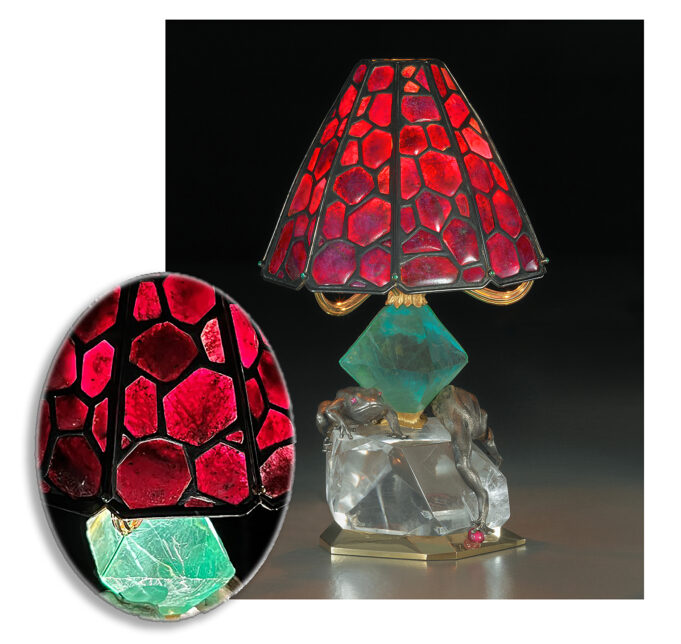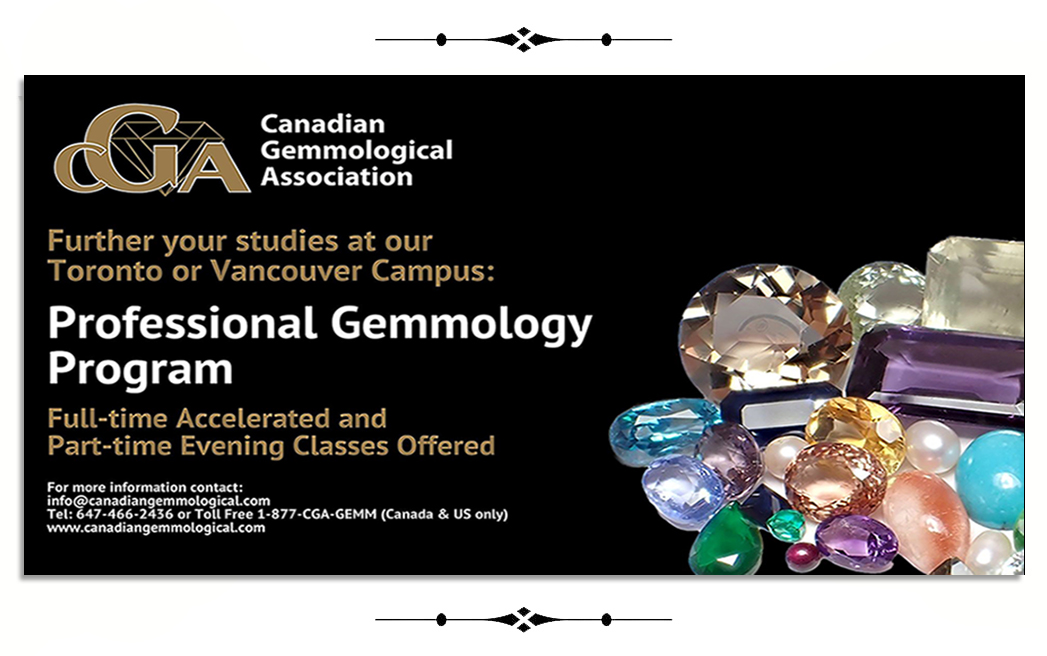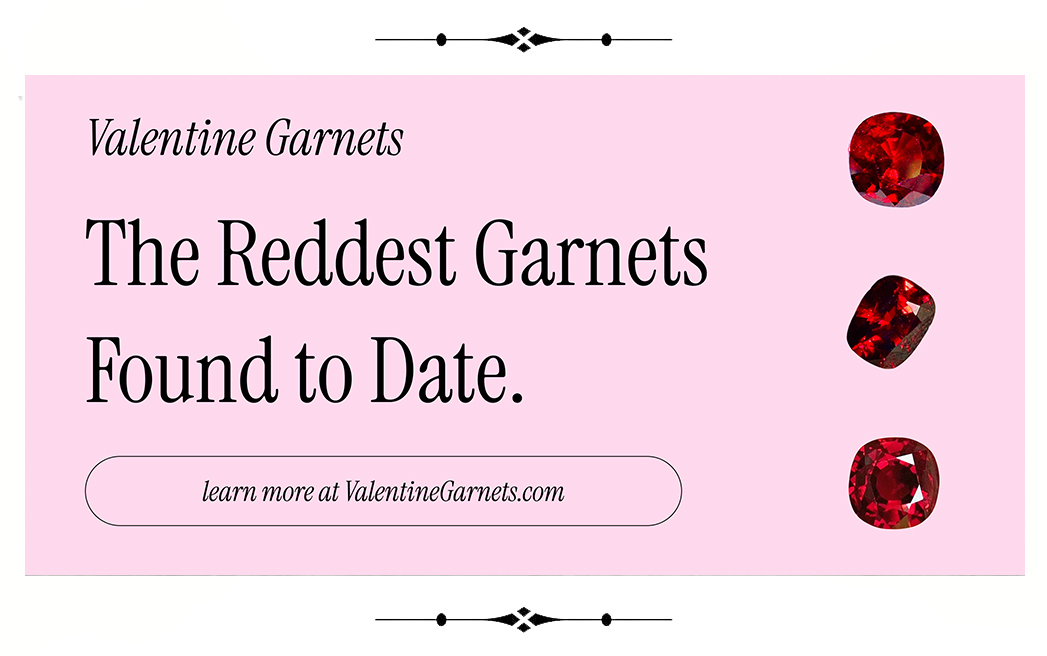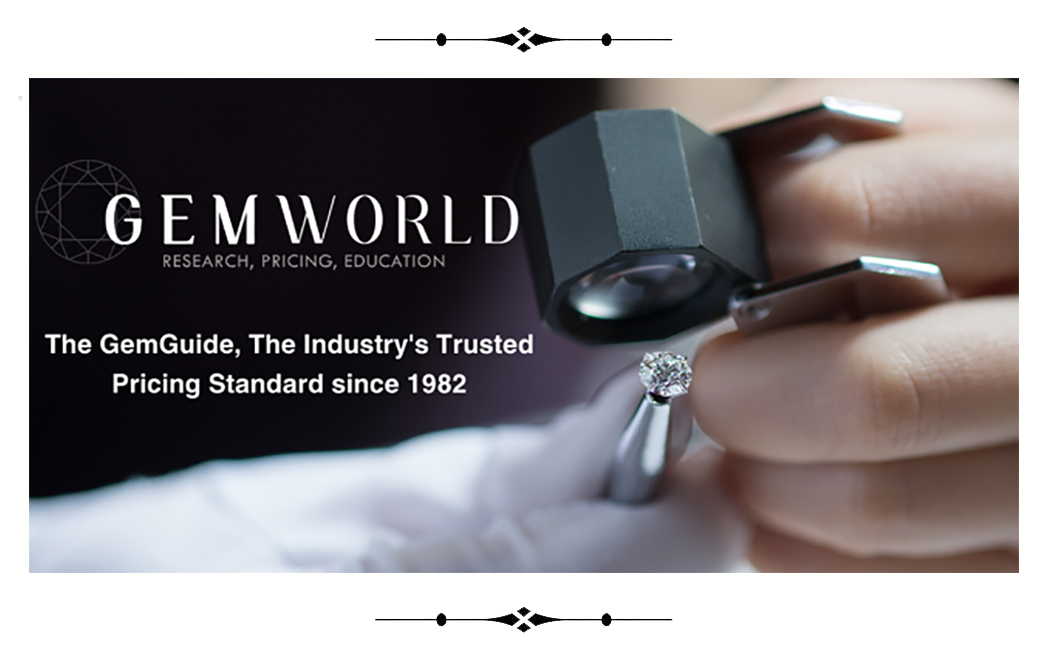Enchanting Imagination: The Objets d’Art of André Chervin and Carvin French Jewelers
Gary Roskin
Roskin Gem News Report
On exhibition at the The New-York Historical Society
170 Central Park West
at Richard Gilder Way (77th Street)
New York, NY 10024
(Right next to the American Museum of Natural History!)
Enchanting Imagination: The Objets d’Art of André Chervin and Carvin French Jewelers is a dazzling exhibition of meticulously created objets d’art, on view to the public for the very first time. André Chervin (born 1927 in Paris, France), with his New York atelier, Carvin French, is one of the most acclaimed makers of handcrafted fine jewelry in the world. Yet unbeknownst to even his most ardent admirers, Chervin’s true lifetime passion was creating a collection of unique, precious objets d’art at Carvin French.
These enchanting one-of-a-kind lamps, clocks, figurines, boxes, personal accessories, and table decorations, are fashioned in gold and silver, with gems such as rubies, diamonds, and sapphires, and masterfully carved jadeite jade, lapis lazuli, amethyst, and rock crystal quartz.
Over the past six decades, Carvin French has manufactured thousands of magnificent pieces for Tiffany & Co., Cartier, Bulgari, Verdura, and other distinguished shops. Though revered by jewelry experts and professionals, the name Carvin French is generally unknown to the public as anonymity was essential to the firm’s success: each jewelry retailer sold the firm’s masterworks under their own brand names.
Several pieces of Carvin French jewelry are shown in the exhibition, including stunning one-of-a-kind brooches such as the extraordinary Butterfly brooch, scintillating with fancy vivid yellow diamonds framed in blackened steel, made for Ralph Esmerian.
Curated by Debra Schmidt Bach, New-York Historical’s curator of decorative arts and special exhibitions.
Major support is provided by Nicola Bulgari. Additional support is provided by Rene Balcer and Carolyn Hsu-Balcer, Kim Manocherian, and Patricia Ross Weis.
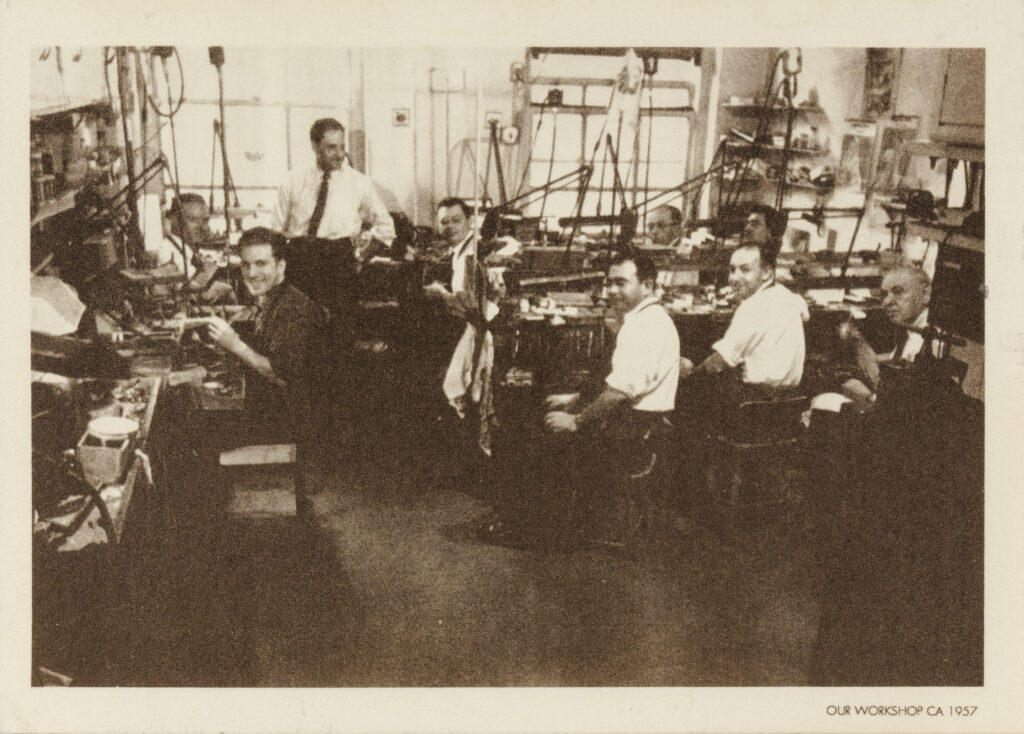
Reproduction photo taken by Glenn Castellano
The name, Carvin French, comes from combining the last names of André Chervin and Serge Carponcy.
And because they were French, and everyone wanted French jewelers, they added that to the name.
Carvin French distinguished itself as a self-contained workshop specializing in hand-fabricated jewelry
with complex stone settings, lapidary work, and enameling, attracting artisans from around the world.
In this photograph from 1957, Serge Carponcy is seen in the back left corner and André Chervin stands next to him.
Hidden Treasures in New York City
The Art of André Chervin, Carvin French Jewelers
On exhibition at the New-York Historical Society now through March 17, 2024, Enchanting Imagination: The Objets d’Art of André Chervin and Carvin French Jewelers.
An interview with Carole Chervin, daughter of famed jeweler André Chervin of Carvin French Jewelers, and Debra Schmidt Bach, Ph.D., Museum and exhibition curator, New York Historical Society Museum.
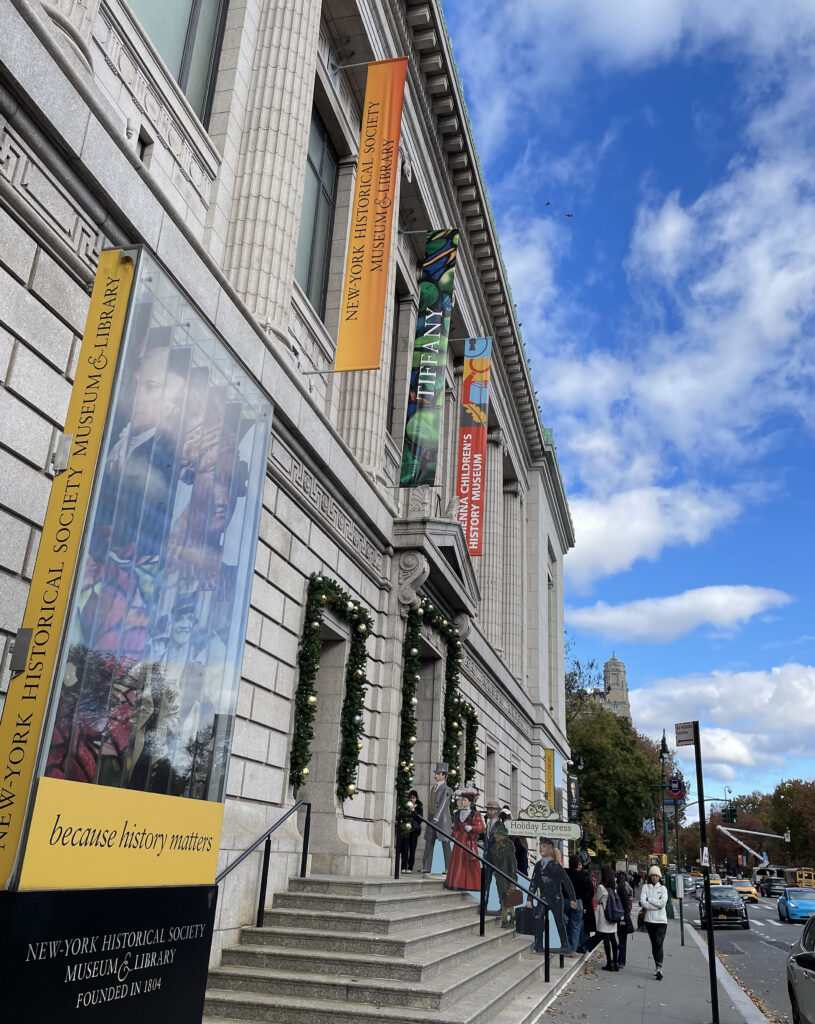
André Chervin & Carvin French Jewelers
Parisian born jeweler André Chervin is the man behind magnificent works of jeweled objets d’art now on display at the New York Historical Society Museum on Central Park West. Curated by Debra Schmidt Bach with the assistance of Carole Chervin, daughter of André Chervin, co-founder of the Carvin French Jewelry studio.
“Like many workshops, there are down times,” notes Carole Chervin. “In order to keep everyone busy, whether it was a break in orders or simply waiting for one jeweler to finish their task on a specific project, André dished out ‘treats’ to the staff…” dreams/designs that were to be made into little gemstone objects.
There are 58 of these dreams in the exhibition, on view to the public for the very first time. None were ever sold or given away as gifts. They remain, to this day, a private Carvin French collection.
NOTE:
If you are planning to visit the exhibition, make sure to be there at the top of the hour. For the first three minutes of every hour, the exhibition hall lights dim, and the Objets d’Art lamps light up. Do not spend too much time at one lamp, as there are many in the room. Remember, you only have three minutes to see how they all appear in the darkened hall.
A Tour of the Exhibition Hall
The objects on display were never sold. “And they were made with that intention,” reiterates Schmidt Bach.
The main focus of the exhibition is on Chervin’s artistic extension beyond jewelry and his creation of bejeweled objets d’art. Conceived and engineered by Chervin and fabricated under his watchful eye by his artisans in between work on commissioned jewelry work, each object evolved over the course of five to 25 years with most measuring a mere three to eight inches in height.
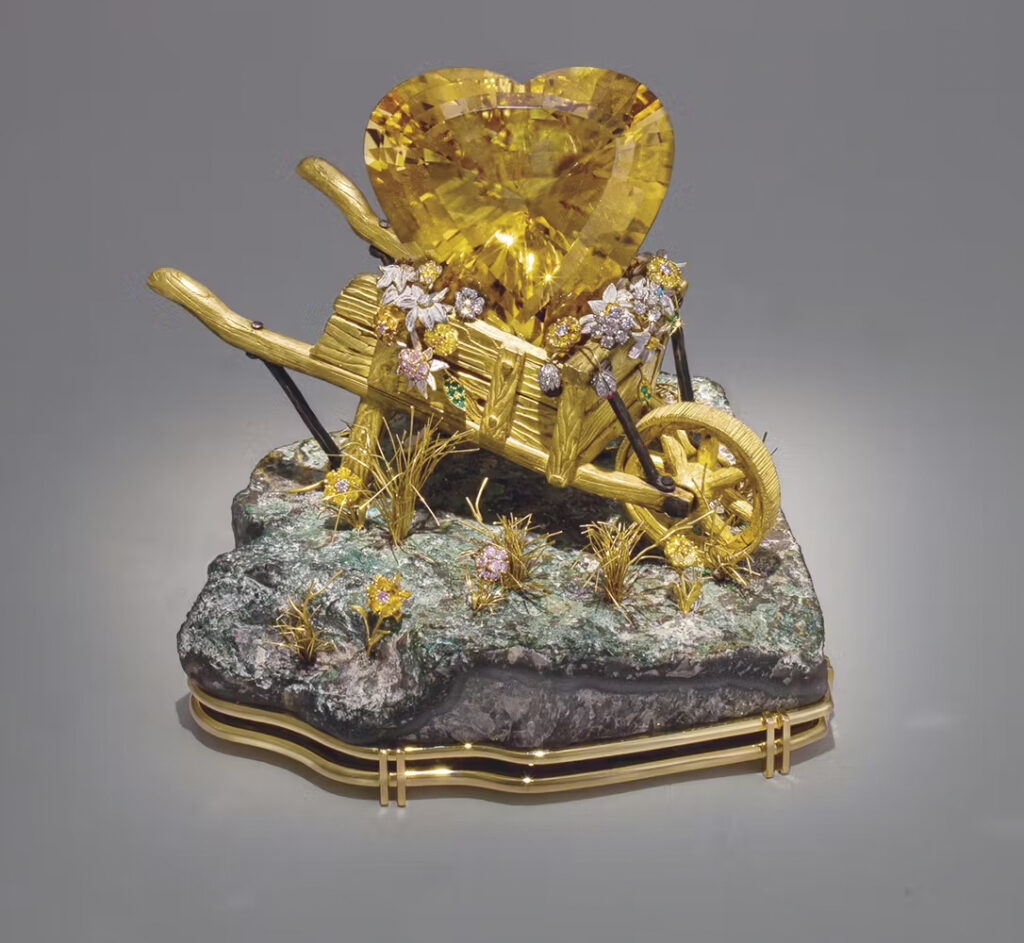
Photo: © David Behl 2022
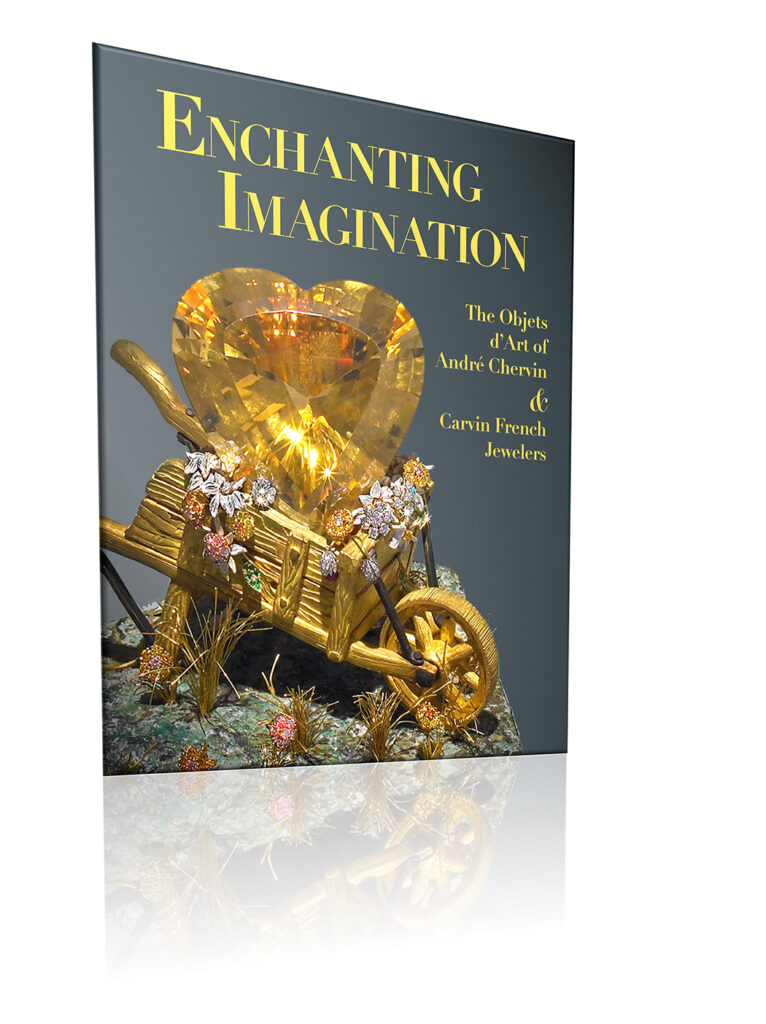
Enchanting Imagination: The Objets d’Art of André Chervin and Carvin French Jewelers introduces André Chervin’s miniature masterpieces—one-of-a-kind lamps, clocks, boxes, personal accessories, and table decorations fashioned from gold, silver, gems and minerals, like rubies, diamonds, sapphires, jade, lapis lazuli, amethyst and quartz. Lavishly illustrated with 110 color photographs, the exhibition catalogue explores Chrevin’s captivating treasures conceived and fabricated under his watchful eye. Each object evolved over the course of many years, taking 5, 10, even 25 years to complete to perfection.
Recognized today as masters of fine jewelry-making whose dazzling creations have been sold by top retail houses such as Tiffany, Van Cleef & Arpels, Verdura, Cartier, and Bulgari, André Chervin (b. 1927) and his firm enjoy a stellar reputation among the clients who wear their refined jewelry. Unbeknownst to his many fans, Chervin also created this collection of precious objets d’art, dating from 1957 to 2013.
Forward by Louise Mirrer
Essays by exhibition curator Debra Schmidt Bach, with André Chervin, and Jeannine Falino
144 pages; 110 color photographs
hardcover
8.25″ x 10″
Highlights include the poignant My Heavy Heart, a boudoir lamp (or “night light”) that incorporates a large, and lit, 732-carat! citrine faceted heart shape, poised atop an 18-karat yellow gold wheelbarrow overflowing with colored diamond flowers. It is based on a parable recounted by Chervin in which a farmer boy professes his love to a local girl, is rejected by her, and then returns to proclaim that his heart is so heavy, he can only carry it in a wheelbarrow.
The Ruby Lamp – Featured Up Front
As you walk into the exhibition hall, the first amazing piece you encounter is the fluorite lamp, highlighting a very large octahedral fluorite, holding up a ruby lamp shade. The fluorite was a piece that André reportedly picked up in Tucson at one of the annual Tucson Gem & Mineral shows. Given to him by a dealer he knew, Chervin remembered bringing it home on the plane in his pocket. [That must have been a pretty big pocket! – gr]
The Rubies des Grenouille boudoir lamp is truly an extraordinary object. Its shade is a mosaic of cut and polished ruby. The mix of rock crystal, fluorite, and little slices of ruby are similar to stained glass in a Tiffany lamp. And if you are familiar with the museum, you know that there is an outstanding exhibition hall just one flight above this exhibition displaying Tiffany glass, including dozens of extraordinary Tiffany lamps. Having this fluorite and ruby lamp at the entry of the Carvin French exhibit was no coincidence.
“We wanted to make that relationship. Our Tiffany collection is huge,” noted Schmidt Bach.
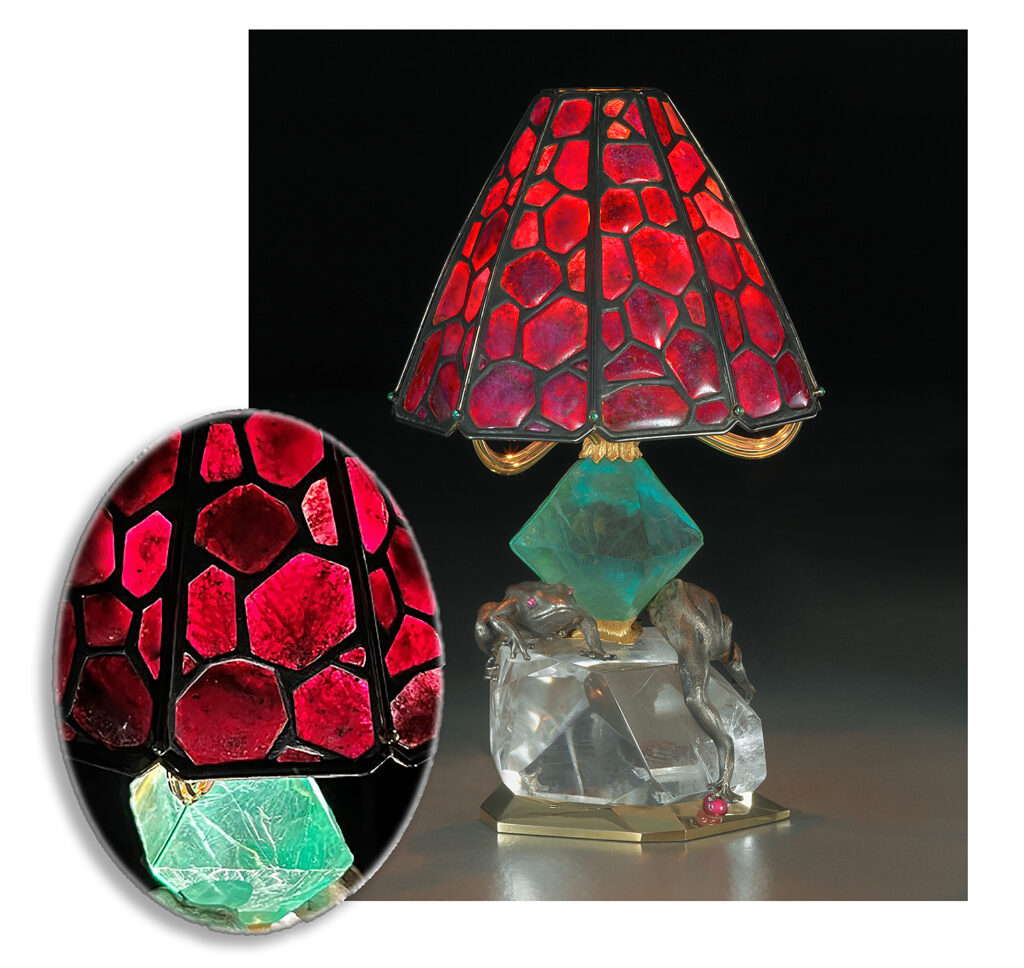
Carvin French Jewelers
Rubies, fluorite, rock crystal quartz, emeralds, sterling silver, 18K yellow gold.
This lamp shade is made of polished ruby plates totaling 664 carats.
The base is constructed of an octahedron of fluorite atop a polished freeform rock crystal quartz,
decorated with sterling silver frogs, set with Burmese ruby eyes.
The secret on/off switch is the gold button beneath a frog’s chin.
8 15/16 x 5 1/8 x 4 1/16 in.
Photo: © David Behl 2022
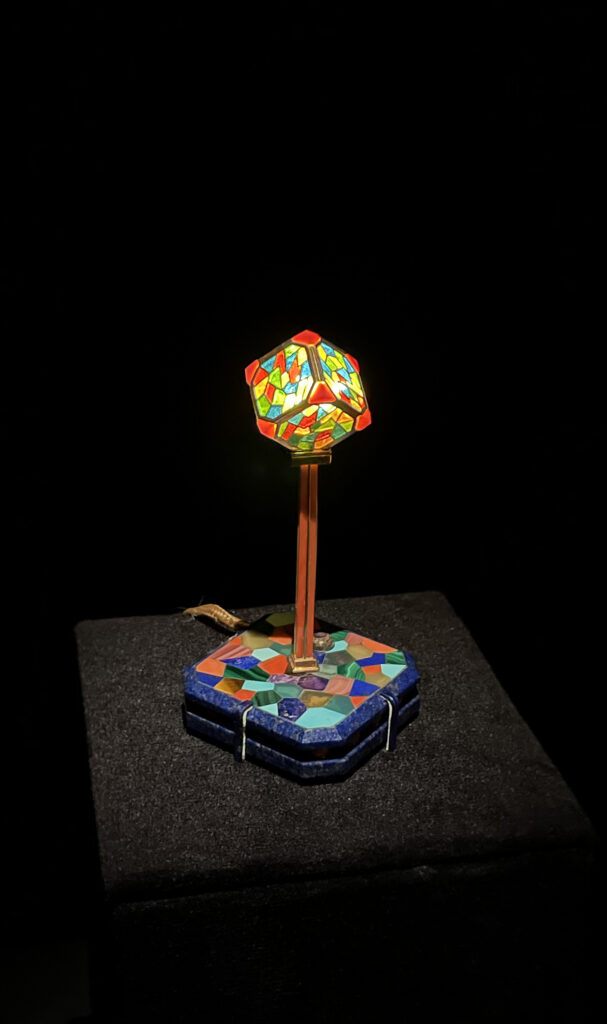
Getting them Ready for Show
It has been quite some time since these pieces were actually shown, to anyone. And so some of the light switches needed to be revitalized. Enter Steven Parker, an Adjunct Assistant Professor in Jewelry Design at the Fashion Institute of Technology in New York, a multi talented jeweler and designer, and owner of Acme Clockworks, the creator of jeweled automata.
“Well, what I did was mostly a lot of repair work on the lamps,” says Parker. “They just really needed some TLC due to age. The wiring had corroded, or the lamps had burnt out, or the switches were oxidized and not functioning anymore.”
Parker admitted that it was not only an honor to be working on such fabulous pieces, but that it was also terrifying. He dismantled many of the pieces to prepare them, and this concerned him, seeing as how they range in age from about 20 to probably 40 or 50 years old.
“So many incredible pieces,” exclaims Parker. “Simply beautiful objects that he just wanted to make. Made from his own creative designs, and they are just wonderful!”
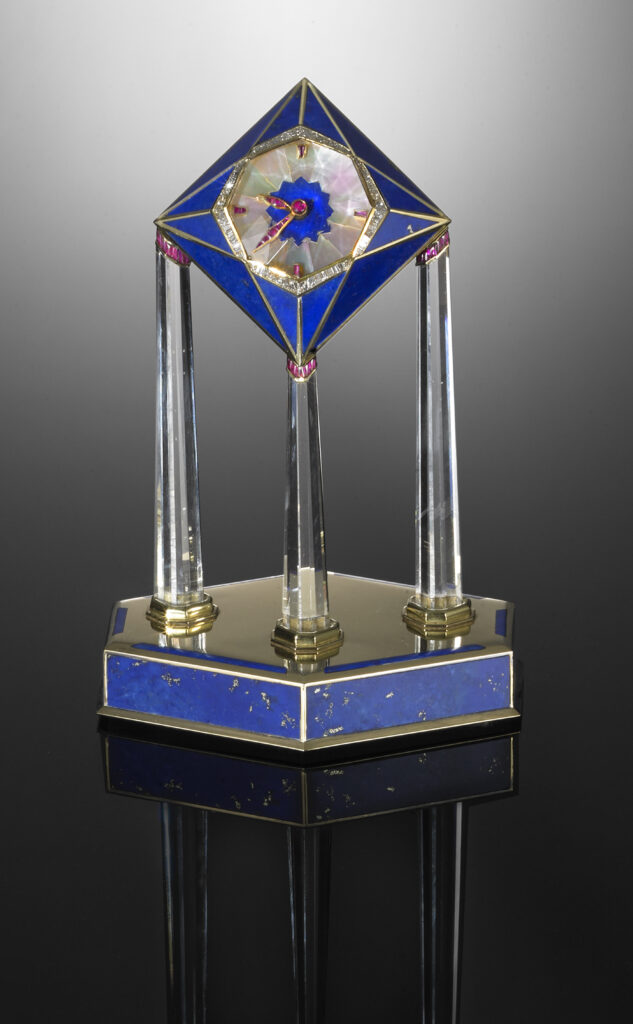
baguette diamonds, rubies, 150H x 107W x 84D
The Lapis Clock Tower features a stunning, lapis lazuli clock with baguette diamonds perched atop a tapered rock crystal column inlaid with precariously thin lapis accents.
Photo: © David Behl 2022
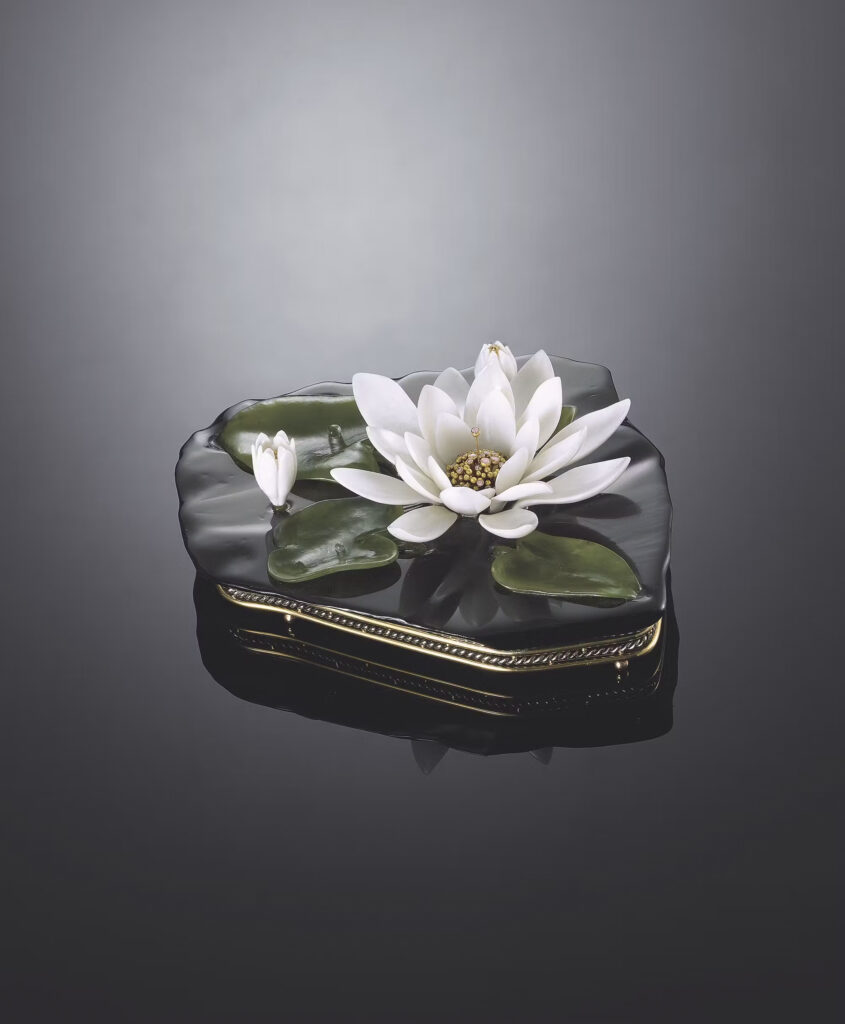
Carvin French Jewelers
White agate, jadeite, pink diamonds, moonstones, rainbow obsidian, 18K yellow gold, sterling silver.
1 7/8 × 5 1/2 × 4 11/17 in.
The miniature water lilies are carved from snow white agate, centering gold beads and 26 pink diamonds,
while the jadeite jade leaves are accented with two moonstone “dewdrops.”
The plants float on an obsidian “pond” trimmed with 18K yellow gold and silver.
Photo: © David Behl 2022
Also on View
Jeweled animals are also on view, including the Bird Guarding Her Nest, with a nest of more than 700 18K yellow gold “straws” with assorted enamel eggs, perched on a sterling silver tree branch and a carved bird of Mexican onyx with coral beak on a base of nephrite; and the Return to Kilimanjaro, featuring a giraffe of enameled 18K yellow gold with emerald eyes, pulling an enameled and bejeweled winter sleigh that carries a Lapis Egg of carved lapis lazuli and 18K yellow gold, set with 200 round diamonds.
Ordinary objects are elevated into works of art, including a pair of cigarette holders made of 18k yellow gold, coral, and black jade set with 60 round diamonds.
There’s a salt and pepper shaker objet, called the Dirty Rotten Scoundrels, a scene where old-time bank robbers, in gold, white agate, onyx, and quartz, are dunked in a vintage, enameled bathtub, complete with vintage claw feet and faucet, and an ingenious “dirty water” surface made of patinated silver. The scoundrels are salt and pepper shakers. “My father always knew the tub would be enamel,” said Carole Chervin, “but he didn’t know how challenging it was going to be… that he’d have to enamel it two or three times over until the enamel looked sort of old and dingy.” After all, old and dingy is not the typical look you’d expect on a new piece of enameled jewelry.
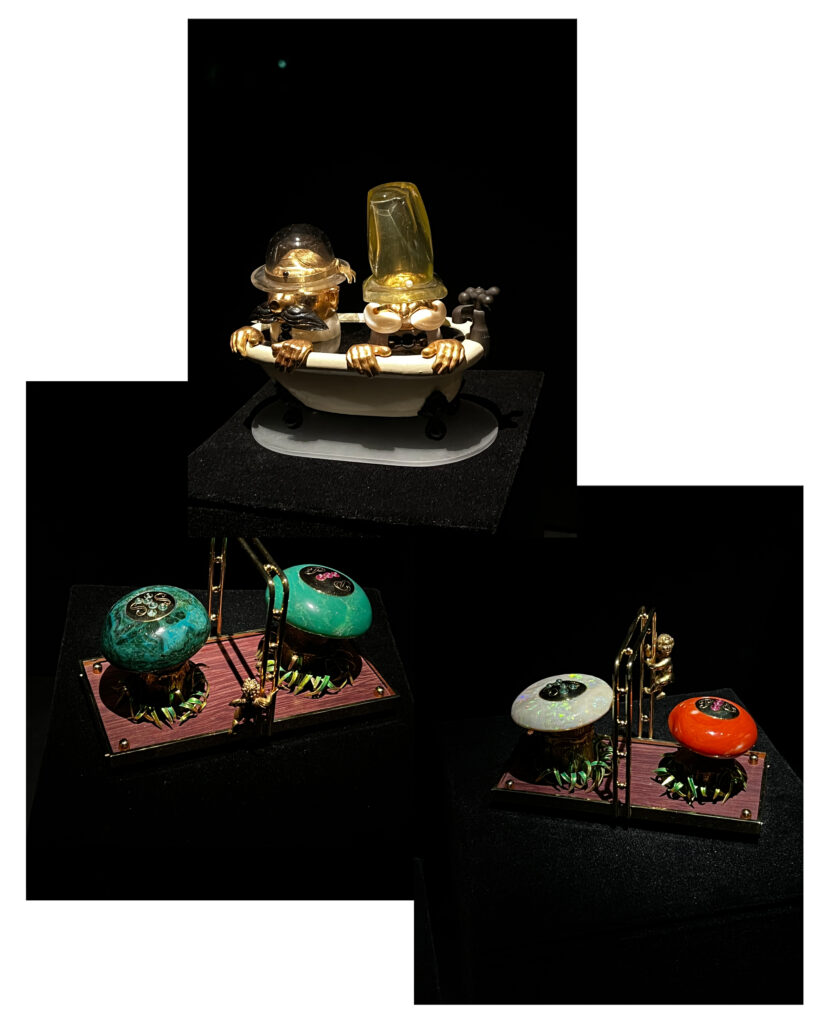
Influenced by the movie Dirty Rotten Scoundrels, this salt and pepper set is another stand out in the hall.
The saltshaker is the one with the white mustache. Pepper has a black mustache. You take their hats off, flip their scalps, and then shake.
Jewelry on Display
Many Carvin French jewelry pieces are included in the exhibition. “We wanted to show just a little bit of the jewelry [on loan for the exhibit] so the visitor could understand what Carvin French did for their bread and butter,” explained Schmidt Bach. “We selected pieces very, very carefully to correspond to the objects in order to see how André jumped from the jewelry to create a work of art.”
All in the Book
The exhibition is accompanied by a fully illustrated catalogue, published by D Giles Limited, featuring essays by Debra Schmidt Bach and Jeannine Falino, available from the NYHistory Store.
Included are fabulous images of the works, many of them including some very fun and interesting quotes from André Chervin about the pieces themselves. Chervin comments on either that individual piece, or about the work that went into the pieces in general.
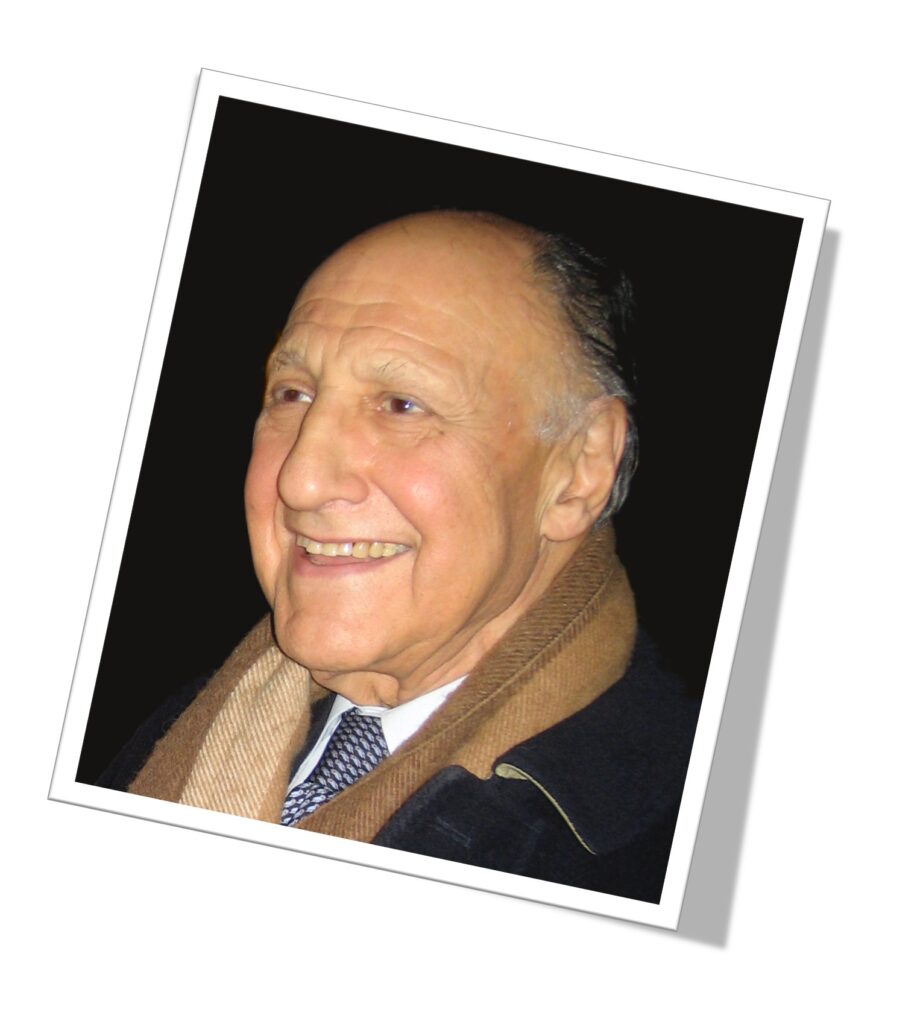
Born in Paris in 1927 to a secular Jewish family involved in the jewelry trade, Chervin lived in the city until World War II forced the family to flee for the south of France. After the war, Chervin enrolled at the Haute École de Joaillerie (est. 1867), the foremost jewelry school in France. When Chervin emigrated to New York in 1951, he found that as a French-trained jeweler, he was in immediate demand. He later met Serge Carponcy, who became his partner in 1954 when the two opened Carvin French Jewelers.
A Lifetime of Work
“This collection represents a lifetime of work,” said André Chervin. “With these objets d’art, I was able to choose myself what to make, and when, and exactly how I wanted them. I was free from the constraints that naturally come when you are manufacturing jewelry for a customer’s order. These are my own expressions. These are my art, pure and simple. These are my true freedom.”
On Display
On display, stunning one-of-a-kind brooches such as the extraordinary Butterfly brooch, set with fancy vivid yellow diamonds framed in blackened steel, made for jeweler Ralph Esmerian, the Gold Frog brooch, and the Lily of the Valley brooch made for the designer Fulco di Verdura.
The Butterfly Brooch
“This butterfly brooch was designed by Carvin French and manufactured by Carvin French for Ralph Esmerian,” explained Schmidt Bach. “And in this instance, Ralph Esmerian had acquired a set of diamonds. And so this was Carvin French’s response to that collection. And you know, again, I just think it’s really an exquisite piece.”
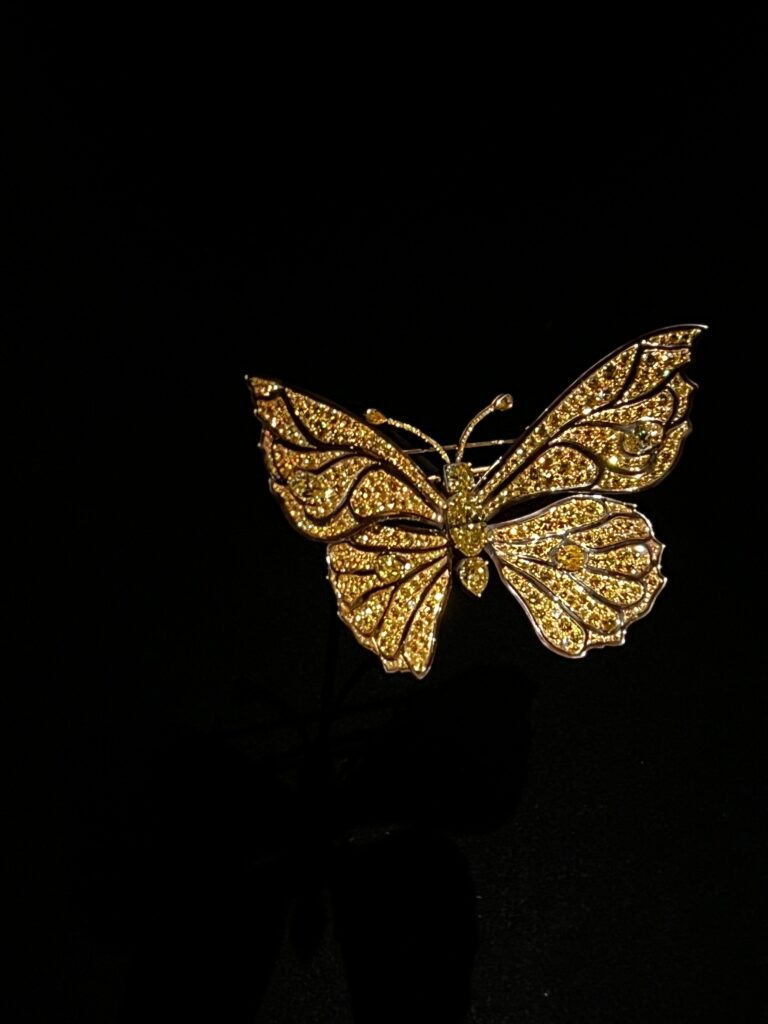
The firm also created many of the opulent pieces featured in Tiffany’s iconic Blue Books and fabricated hundreds of one-of-a-kind bracelets, rings, earrings, brooches, cufflinks, and necklaces in collaboration with Tiffany’s leading jewelry designers, Donald Claflin and Angela Cummings, including the Mouse brooch made of diamonds, colored diamonds, pearls, gold, platinum, and enamel.
Enamel Works
In the exhibit, there are numerous pieces of art embellished with enamel, along with several jewels.
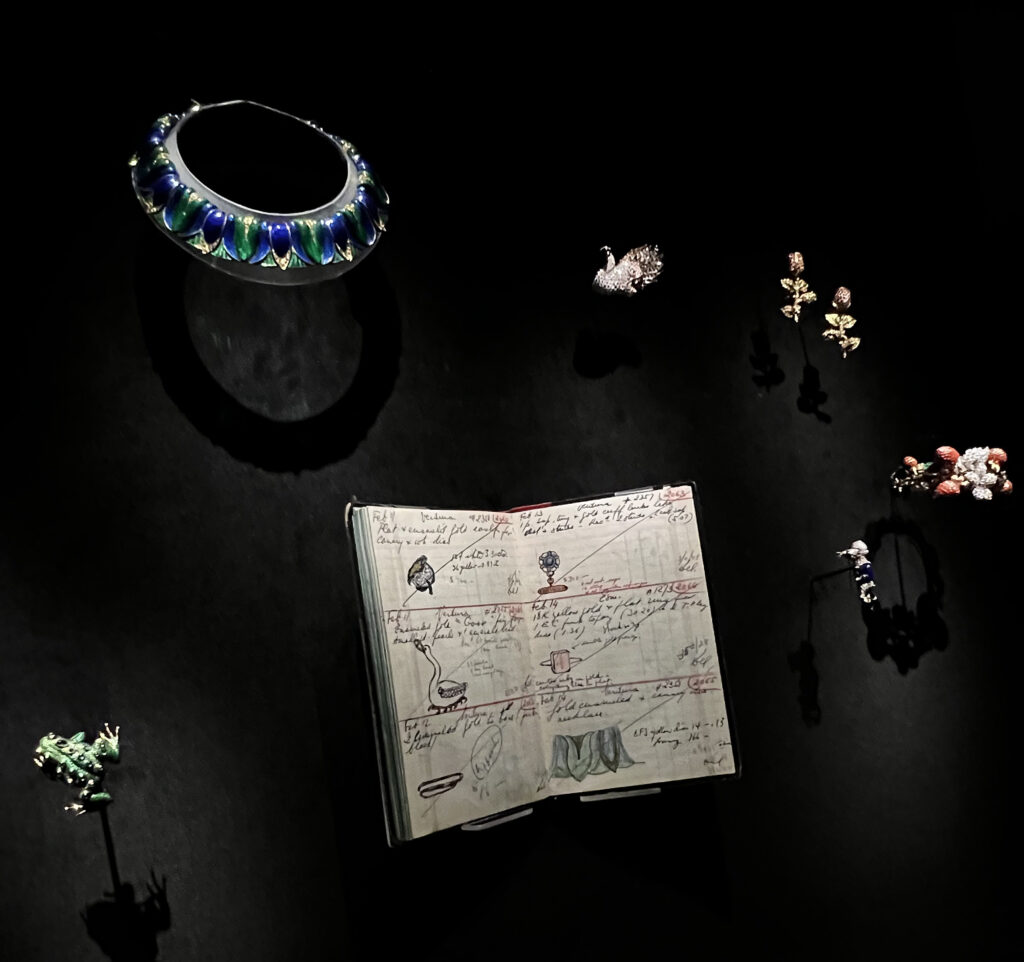
Carvin French Jewelers, manufacturer
Yellow Diamonds, 18K yellow Gold, Blue and Green Enamel
Verdura Archives
About that Necklace
The Verdura connection was where Carvin French launched into becoming a well-known specialist in enamel works.
Also on exhibit in the jewelry case is an enameled piece called the Lotus Leaves necklace, in bright green and bright royal blue. Yes, “royal blue.”
The intricate Lotus Leaves necklace designed by Fulco di Verdura in 1964 made by Carvin French with a rare, historic, royal blue enamel that once was reserved exclusively for Marie Antoinette.
Royal Blue Enamel
“It was well before he got the commission for the necklace,” notes Carole Chervin. “He was walking in Paris where there were lots of small jewelry supply stores. He noticed one in particular where there was a lot of activity. They were moving around big cartons. He was curious. When he asked the workers what was going on, they replied that they were closing the shop. They were sending everything off to be liquidated at auction.”
Well, Chervin couldn’t pass up this opportunity to look around. “So he looked through the boxes, and among other things, he found packets of enamel powder.”
And not just any enamel packets. On one packet, written in pencil, was “Bleue Madame.” Chervin knew what that meant, but he could hardly believe it. So, he checked with the workers to see if he was thinking correctly. “Is this what I think it is?” he asked. And they replied, “It sure is.” “Bleue Madame” is the enamel that was reserved exclusively, by law in the 18th century, for use by the Royal Court, and specifically for the porcelain of Marie Antoinette.
“This was that fabulous blue marine color that was, by law, restricted, could only be used for her. It was literally a royal blue!” exclaimed Carole Chervin.
“Wow, do you know, this is 200-year-old powder? And it’s still good!”
Chervin bought it all. He took it home to New York, and made that Verdura necklace, as well as some other pieces. “And whenever a customer, whether it be a private individual or a retail store, whether they knew the story or not, they were always very impressed with the gorgeous dazzling color.”
And there is SO much more about this exhibition!



